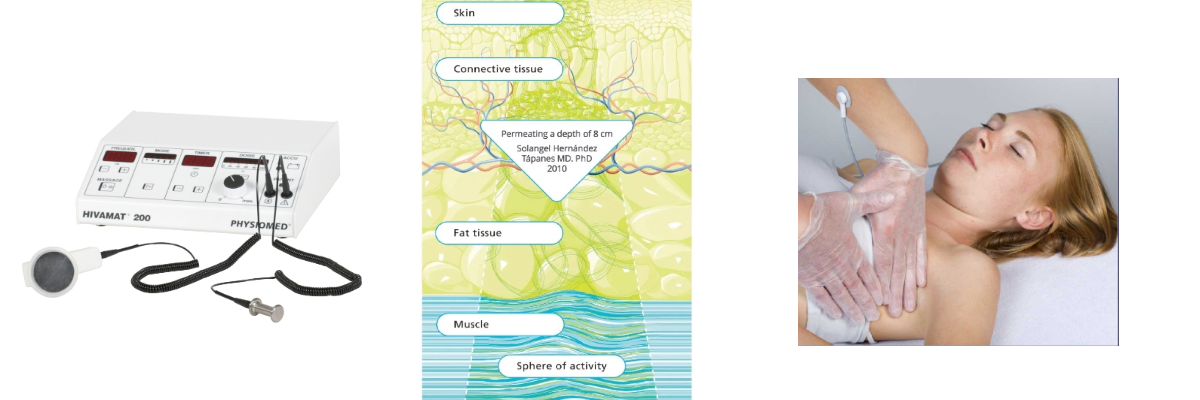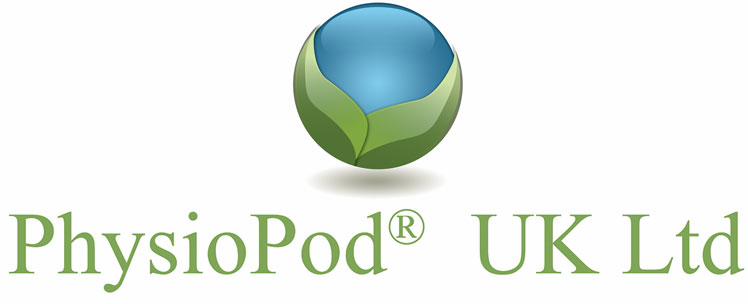Case Study: Manual Lymphatic Drainage with Deep Oscillation Post Breast Uplift and Augmentation
With thanks to Catherine Groom, MLD UK, DLT Vodder and Casley Smith MLD Practitioner and Specialist Lymphoedema Practitioner (BLS Member)
Background
I was fortunate to buy a Hivamat some 13 years ago and it continues to be an integral part of my daily work in the management of swelling for both lymphoedema and post-operative swelling.
It is a valuable addition to the hands on treatment of MLD without distracting from the skill of MLD itself. The electrostatic field created between the therapists hands and the skin of the patient causes a gentle vibration (oscillation) which is relaxing and comfortable. The hands on treatment of MLD is enhanced by the vibration created through deep oscillation, enabling deeper penetration into the tissues. Although thin vinyl gloves are worn, it is still possible to feel the tissues and the changes in the structure of the tissues.
Patient A was 38 years old and was dissatisfied with the change in her breast form and position since having her children, having lost a significant amount of weight post-pregnancies. She had undergone surgery abroad for a breast uplift and augmentation and was one week post surgery. She had dissolvable stitches and had not experienced any complications, was in good health and had not had any other MLD after surgery.
She was wearing a compression vest and her scars were still dressed. She was instructed to wear the vest for 6-8 weeks.
Following an explanation of the lymph system and the MLD method, breathing techniques and simple upper body exercises were demonstrated. These were then carried out while being monitored. Before beginning the therapy, the use of deep oscillation was described, and a demonstration on her arm was given to feel the sensation of the vibration..
Assessment before treatment
Bilaterally the breast tissue was extremely firm on palpation. Swelling was evident to the breast with only slight swelling around the post axillary fold.

The patient certainly felt discomfort in the tissues and could only lay supine. She described her pain level as 8 out of 10. There was no skin movement. The scars were still covered in dressings.
MLD treatment with Hivamat

Treatment One - 1 Hour
- Following a combination of Vodder and Casley-Smith MLD techniques.
- Breathing exercises including the ‘wave’ breath and deep abdominal breathing were carried out prior to MLD commencing.
- Simple arm exercises taking the arms across the front of the body and stretching back x 5
- Working within patient comfort, taking the arms upward towards the head x 5
- Neck clearance, supra clavicular fossa clearance
- Axillary clearance working each side separately
- Clearance of breast following axillary clearance on ipsilateral side of cleared axilla
- Very gentle/subtle movement of breast by cupping hands around breast and gentle ‘pumping’ movement to help ‘loosen’ solid breast
- Clearance of ipsilateral parasternal nodes
- Clearance of ipsilateral intercostal nodes
- Deep abdominal breathing
- Bilateral axillary clearance
- Repeated neck clearance
- Repeat of wave breath and gentle arm exercises.
- Hivamat commenced at 150Hz increasing to 200Hz as treatment progressed
Treatment 2 and 3 were carried out on consecutive days, following treatment 1.
The same routine was carried out with slight adjustments to pressure, due to softening of the tissues. Hivamat was used with the same frequencies (150/200).
Results
Patient feedback was so positive following treatment one (pain scale reported as 1 out of 10) that virtually the same routine and movements were carried out, with only slight adjustments due to the softening of the tissues after treatment one. She had loved the experience of the MLD with deep oscillation. She found it comfortable and relaxing. She said she had been surprised with the positive effect after just one treatment.
Patient Feedback
I went to see Catherine one week post surgery breast uplift and augmentation due to pain and swelling. Catherine was very helpful from the moment I booked and before treatment use diagrams and pictures to explain the lymphatic system and what she would be doing and how this would benefit me. Before my massage my pain levels were in 8 out of 10 and the skin was so tight due to swelling and they felt Immediately better after the massage but when I woke up the following morning I was amazed, the swelling had gone down considerably and I was virtually in no pain, down to one out of 10. I went back to Catherine for two further massages and honestly don't know how I would've managed without them. Her technique, professionalism and knowledge were outstanding and I felt in very safe and capable hands, even with healing surgical wounds. I will sing her praises from the rooftops to anyone that will listen and highly recommend manual lymphatic drainage massage with her to anyone who is post surgery.
Ilkley, LS29 6RT
Previous Reports from Catherine Groom:
1. "Manual Lymphatic Drainage as a stand-alone treatment gives good results over time..Since introducing HIVAMAT® 200 we have found the results happen more quickly, especially when softening fibrosis or scar tissue. The advantage for the Practitioner is that they are still delivering a hands-on treatment, just with the addition of gloves. This enables them to feel the tissues as they work, adjusting their movements and depth of working alongside the frequency of the oscillations to obtain optimum results for the patient. It also still enables good control of their hands in delicate and small areas. The treatment is pleasant to receive and we have only ever had positive feedback. The treatment of Head and Neck oedema can be challenging for both therapist and patient. To be able to achieve effective results more quickly is hugely positive for the patient. It also frees up clinic slots to enable more patients to be treated. The use of HIVAMAT® 200 has definitely improved the overall treatment opportunities we can give our patients.
Catherine Groom, MLD UK, PHIA Vodder and Casley Smith MLD DLT Practitioner and Lymphoedema Therapist (BLS Member), Wharfedale Hospital, Leeds Teaching Hospitals NHS Trust
2. Self-Care of Leg Lymphoedema by Catherine Groom - Specialist Lymphoedema Practitioner
Please note the DEEP OSCILLATION PERSONAL PRO has replaced the HIVAMAT 200

WHY DO PEOPLE CHOOSE TO HAVE A BREAST LIFT AND BREAST AUGMENTATION AT THE SAME TIME?

There are several reasons people choose to combine lifting and augmentation. Combining a breast lift with augmentation allows for a comprehensive improvement in breast appearance. While a breast lift lifts and reshapes sagging breasts, a breast augmentation enhances their size and shape. By having both procedures together, individuals can achieve optimal results in terms of breast position, volume, and overall aesthetics.
Undergoing a combined breast lift with augmentation saves time and reduces the need for multiple surgeries. Instead of undergoing two separate procedures with separate recovery periods, combining them allows for a more streamlined process, resulting in a shorter overall recovery time.
Symmetry and balance: For individuals who have breasts that are both sagging and lacking in volume, a combined procedure can help to achieve symmetry and balance. By lifting the breasts and adding implants, the surgeon can create a more proportionate and harmonious appearance, addressing both sagging and volume concerns simultaneously.
It's important to note that the decision to have a breast lift and augmentation together depends on individual factors such as breast anatomy, skin elasticity, and personal goals. Consulting with a qualified plastic surgeon will allow for a proper assessment and the best treatment plan for achieving the desired outcome.
WHY DO PEOPLE CHOOSE TO HAVE THIS TYPE OF SURGERY AFTER HAVING CHILDREN?

Many individuals choose to have a breast lift and breast augmentation after having children for various reasons. Here are some common motivations:
1. Restoring Volume and Shape: Pregnancy, breastfeeding, and the natural aging process can cause changes to the breasts, resulting in loss of volume, sagging, and stretched skin. A breast lift can address sagging by lifting the breasts to a more youthful position, while breast augmentation can restore lost volume, enhancing the shape and fullness.
2. Correcting Changes in Breast Size: Pregnancy and breastfeeding often lead to fluctuations in breast size. After weaning, some individuals may find that their breasts have decreased in size or become asymmetrical. Breast augmentation can help restore balance, ensuring that both breasts are symmetrical in size and shape.
3. Boosting Self-Confidence: Having children can be a transformative experience, and changes in one's body can impact self-esteem and body image. A breast lift and augmentation can help individuals regain confidence by addressing their concerns and achieving the desired breast appearance.
4. Reclaiming Pre-Pregnancy Body: Some individuals seek a breast lift and augmentation to regain their pre-pregnancy body or to achieve the aesthetic goals they had before having children. It can provide a sense of empowerment, helping individuals feel like themselves again.
It's vital to have a thorough consultation with a qualified plastic surgeon to discuss your goals, expectations, and suitability for a breast lift and augmentation. They can evaluate your specific circumstances and determine the most appropriate approach for achieving the desired results.
WHAT IS THE AFTERCARE ROUTINE FOLLOWING BREAST LIFT AND AUGMENTATION?

After a breast lift and augmentation surgery, it is essential to follow a proper aftercare routine to promote healing and achieve optimal results. While the specific instructions may vary depending on individual circumstances and your surgeon's recommendations, here are some common elements of a post-operative breast lift and augmentation aftercare routine:
1. Dressings and bandages: Your surgeon will apply dressings and possibly a supportive bra immediately after surgery. You may be instructed to wear a compression bra or surgical bra to help reduce swelling and provide support during the initial healing phase.
2. Recovery timeline: You will be advised on the expected recovery timeline, including when you can resume normal activities, exercise, and return to work. It's crucial to follow these guidelines to avoid complications and allow your body to heal properly.
3. Pain management: Your surgeon may prescribe pain medication or recommend over-the-counter pain relievers to manage any discomfort or pain during the recovery period.
4. Physical activity: It's important to avoid strenuous activities, heavy lifting, or any activity that puts pressure on your breasts for a specified period as advised by your surgeon. Gradually, you will be able to resume normal activities and exercise under their guidance.
5. Hygiene and wound care: You will receive instructions on how to care for the incision areas and any drains, if placed. This may involve cleaning the incisions, applying prescribed ointments or dressings, and keeping the surgical area dry and clean.
6. Follow-up appointments: Your surgeon will schedule post-operative follow-up appointments to monitor your healing progress, remove any sutures, and address any concerns or questions you may have.
It's crucial to closely follow the aftercare instructions provided by your surgeon, as they have specific knowledge of your case and can provide personalized guidance. If you experience severe pain, excessive bleeding, signs of infection, or have any other concerns during your recovery, it's important to promptly contact your doctor.
WHY MIGHT I CONSIDER DEEP OSCILLATION® WITH VODDER AND CASLEY-SMITH MLD FOR POST BREAST LIFT AND AUGMENTATION?

Incorporating Deep Oscillation® with Vodder and Casley-Smith MLD after breast lift and augmentation can be beneficial for several reasons:
1. Pain and Discomfort Relief: Following breast surgery, it is common to experience pain, discomfort, and muscle tension. Deep Oscillation® therapy can help alleviate these symptoms by promoting relaxation and reducing muscle stiffness. MLD techniques applied during the treatment can also help relieve tension and promote a sense of relaxation.
2. Improved Circulation: Deep Oscillation® therapy enhances microcirculation, which promotes the delivery of oxygen and nutrients to the tissues. This can aid in the healing process, reduce inflammation, and support the overall well-being of the treated area.
3. Enhanced Scar Healing: By stimulating blood flow, Deep Oscillation® can contribute to better scar healing. It can help reduce the formation of adhesions and fibrosis, leading to smoother and less noticeable scars. MLD techniques can also improve scar elasticity and prevent the development of hypertrophic or keloid scars.
4. Psychological Support: Breast lift and augmentation procedures can have an emotional impact on individuals. Deep Oscillation® therapy, with its gentle and comforting nature, can provide psychological support by promoting relaxation, reducing anxiety, and enhancing overall well-being.
All Deep Oscillation Publications
WHAT IS WAVE BREATHING?
Allow the sound of the "ocean" to soothe and focus your mind. As you breathe in deeply, feel your belly and ribcage expand and imagine a wave rushing in and filling you up. As you breathe out, feel your belly fall and ribs relax together and imagine the wave receding from the shore.
- Start with hands in prayer position
As you take a deep breath through your nose, stretch your arms back, squeezing your shoulder blades
Then with a strong outward (huff) breath, bring your arms back across your chest, so they cross at the waist. - The goal of wave breathing is to promote relaxation, reduce stress, and improve oxygen circulation throughout the body. It can help calm the nervous system, lower heart rate, and increase overall feelings of well-being.
Regular practice of wave breathing can be beneficial in managing stress, anxiety, and even improving sleep quality. It's important to note that if you have any respiratory or medical conditions, it's best to consult with a healthcare professional before incorporating any new breathing techniques into your routine.
WHAT ARE THE EXERCISES RECOMMENDED AFTER BREAST LIFT AND AUGMENTATION?
.jpg)
After breast lift and augmentation surgery, it is important to follow your surgeon's recommendations regarding exercise and physical activity. Typically, gentle arm exercises can be gradually introduced to promote mobility, prevent stiffness, and aid in the healing process. Here are a few recommended gentle arm exercises that may be appropriate after breast lift and augmentation:
1. Pendulum swings: Stand beside a stable surface and gently lean forward, placing one hand on the surface for support. Allow your opposite arm to hang freely. Begin making small circular or back-and-forth movements with your arm. This exercise helps improve range of motion and flexibility.
2. Shoulder shrugs and rolls: Sit or stand upright and raise your shoulders towards your ears in a shrugging motion. Hold for a few seconds, then relax and roll your shoulders forward and backward in a circular motion. This exercise helps relieve tension and promotes shoulder mobility.
3. Wall slides: Stand facing a wall with your palms resting against it at shoulder height. Slowly slide your hands up the wall as far as you comfortably can and then slide them back down. This exercise helps gently stretch the chest muscles and promotes range of motion in the shoulders.
4. Bicep curls: Hold a light dumbbell or a resistance band in each hand, palms facing forward. Keep your elbows close to your sides, and slowly bend your elbows to lift the weights towards your shoulders. Lower the weights back down with control. This exercise helps strengthen the biceps.
Always start with light resistance or no weights and gradually increase the intensity as advised by your surgeon or physical therapist. It's important to listen to your body and avoid any exercises that cause discomfort, pain, or excessive strain. If you experience any concerns or limitations, consult with your healthcare professional before proceeding with any exercise routine.
Remember to follow your surgeon's specific guidelines regarding the timing and progression of exercises after breast lift and augmentation surgery, as individual surgical techniques and healing processes can vary.


